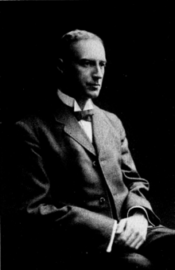
By day, he was a mild-mannered professor of physics. By night, he was the midnight phantom of a Harvard lecture hall. Today, because of his unusual experiments with seat cushions, Wallace Clement Sabine is known as the father of architectural acoustics.
Wallace Sabine is the physicist credited with the modern science of architectural acoustics. Sabine attended Harvard University for graduate studies in physics. He was appointed assistant professor of physics in 1890. Although, he neglected to take a Ph.D., Sabine devoted himself to teaching instead. In fact, his courses become some of the most popular in the department.
Testing Acoustics with Seat Cushions
In 1895, Sabine embraced a challenge: to turn an acoustically impossible lecture hall at Harvard into a usable room. For several years, Sabine and his assistants experimented with and observed sound characteristics of the room. At this time, they would borrow hundreds of seat cushions from the Sanders Theater. The theater is known for its acoustic excellence. Using organ pipes, they’d measure the time it took for different frequencies of sound to become inaudible with different materials. Every morning following these experiments Sabine and his assistants would return both the lecture hall and the Sanders Theater to their original states for use that day. Based his experiments, Sabine developed an equation that made it possible to calculate and predict reverberation time in a room.
 .
.
The Boston Music Hall
In 1900, Sabine undertook the job of acoustical consultant for the New Boston Music Hall. After analyzing the completed designs for the hall, Sabine determined that it would have been an acoustical nightmare. Utilizing Sabine’s knowledge and experience, a new design was developed and the hall was completed. The New Boston Music Hall, now known as Symphony Hall is still said to be one of the best concert halls in the world.
Sabine also had an uncanny talent for putting abstract concepts and theories into practical uses. In one of his presentations he gave a description of sound reverberation that serves as an excellent example. “In the lecture room of Harvard University… the rate of absorption was so small that a word spoken in an ordinary tone of voice was audible for five and a half seconds afterwards. During this time even a very deliberate speaker would have uttered 12 or 15 succeeding syllables. Thus, the successive enunciations blended into a loud sound, through which and above which it was necessary to hear and distinguish the orderly progression of the speech.”
Other Notable Accomplishments
It was problems like these that Sabine sought to eliminate. He made many more discoveries and performed many experiments before his death in 1919. One notable experiment found him discovering the relationship between sound absorption in a room and sound transmission through solid materials. With all of his discoveries and explanations, Sabine laid the foundation for architectural acoustics. In his honor, the international unit of sound absorption is the sabin.